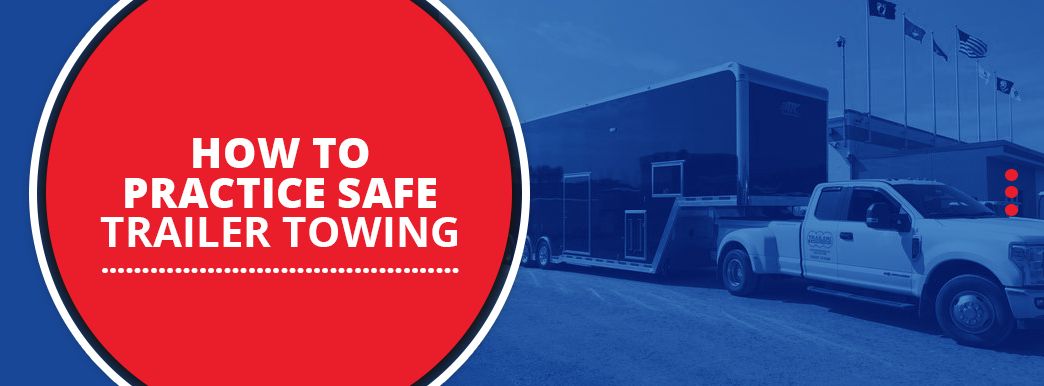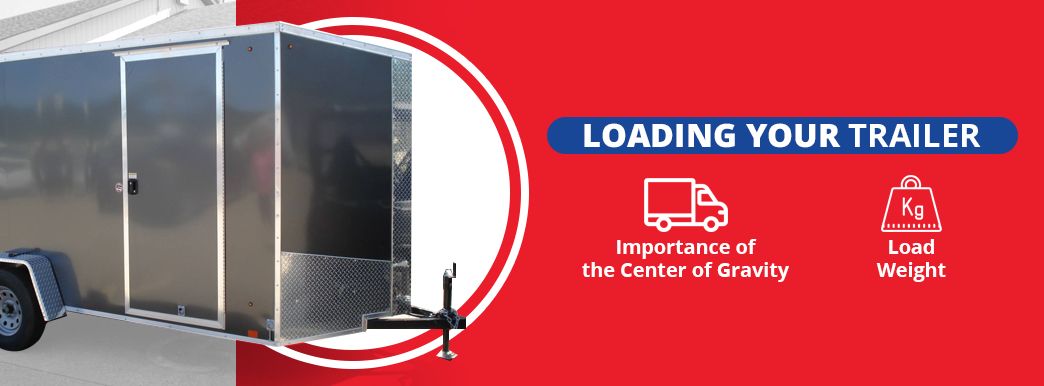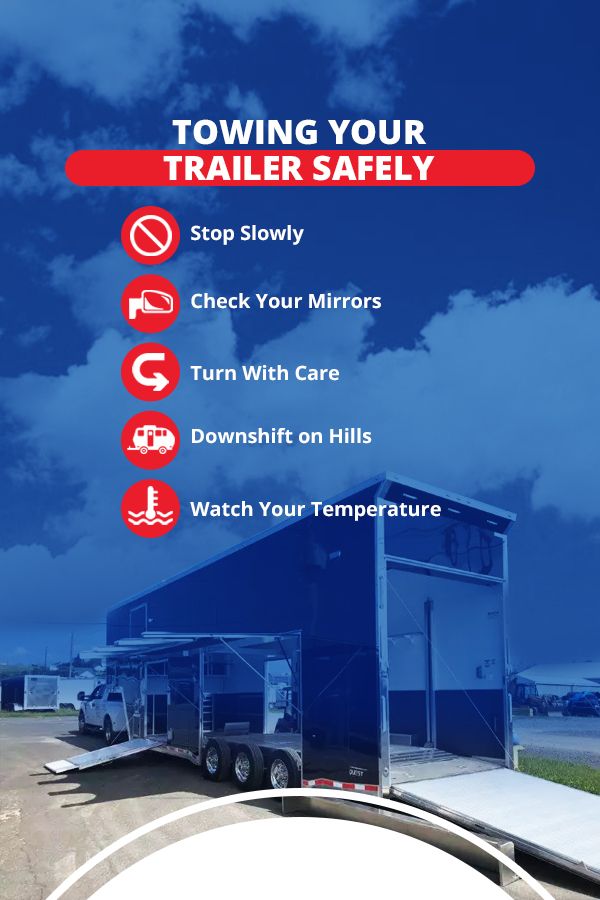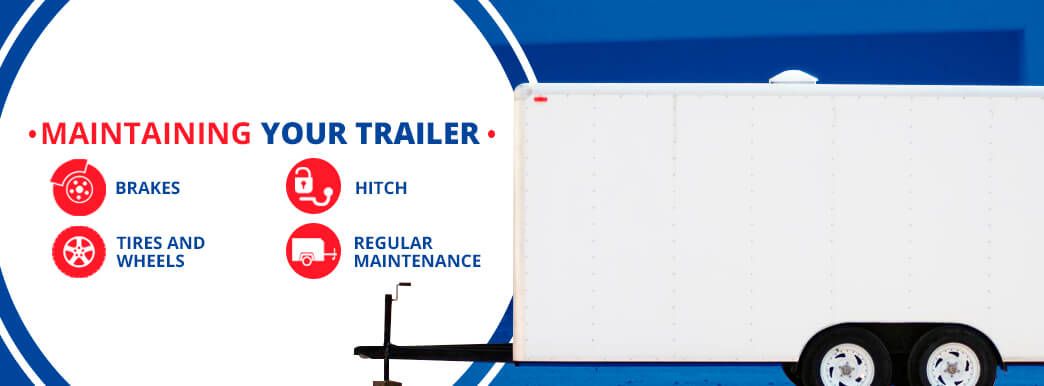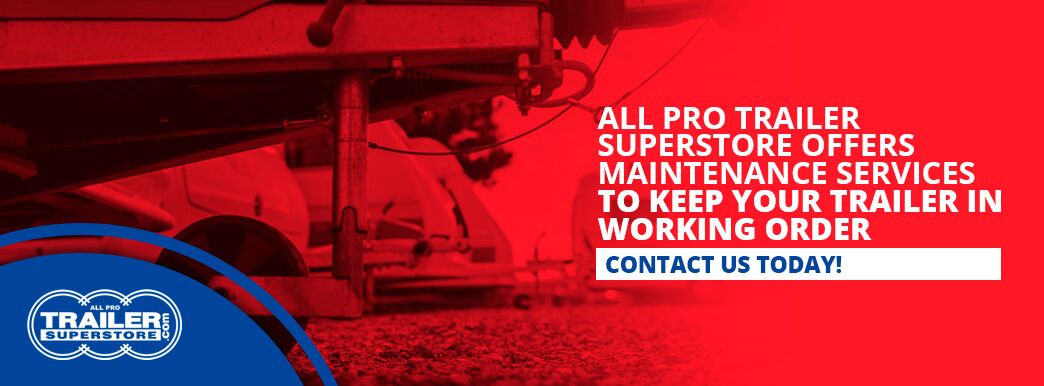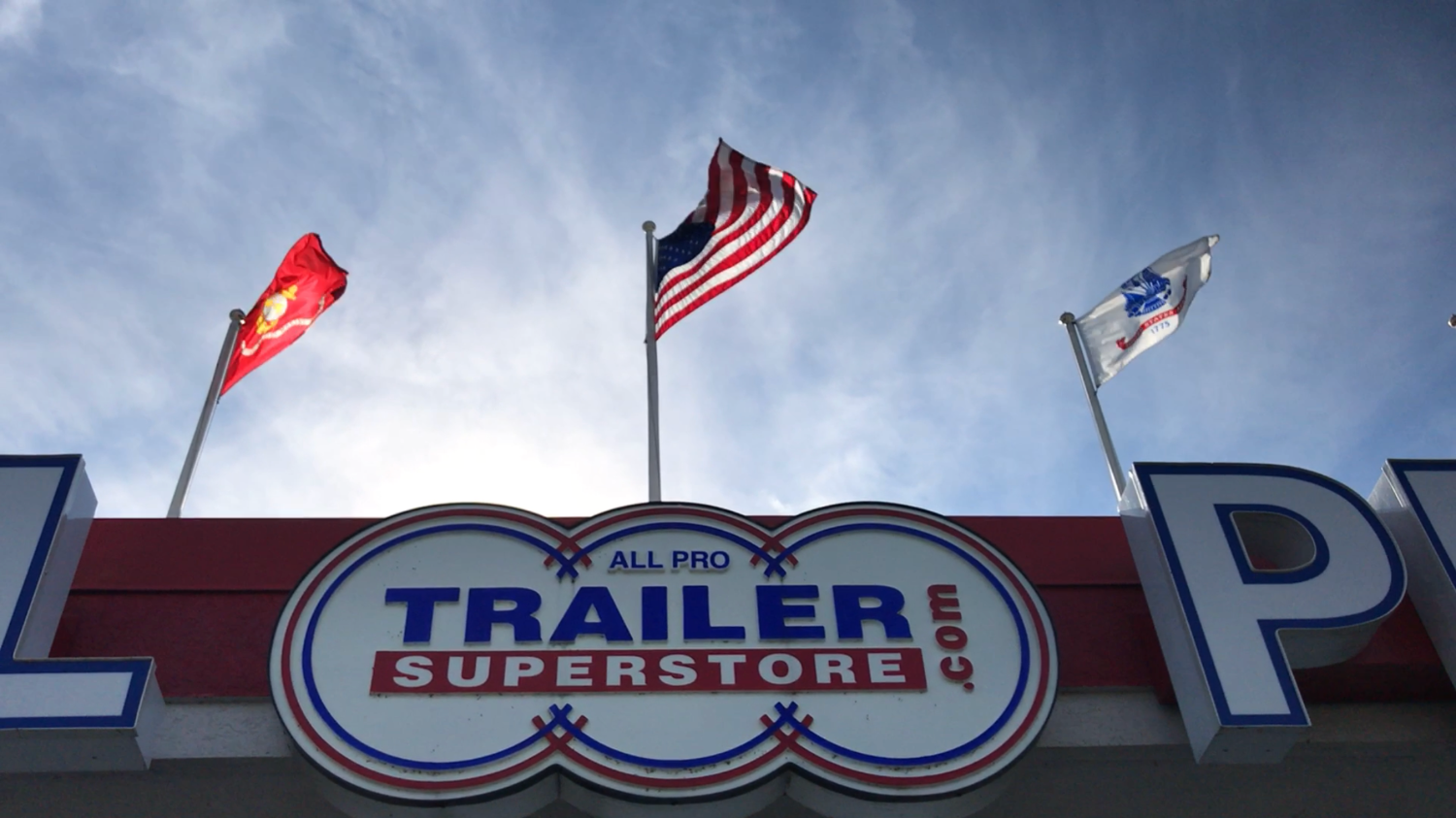How to Practice Safe Trailer Towing
Jul 26, 2019Last Updated on September 30, 2024 by Alex Bobb
Last Updated on September 30, 2024 by allprotrailersuperstore
Don’t let safe towing become a drag on your trip. Learn to load, drive and maintain your trailer to make it safer to use. You wouldn’t get behind the wheel without knowing how to drive your vehicle, so why would you haul anything without knowing how to safely manage your trailer? Make the time to learn everything you need for safe trailer towing now.
Table of Contents
- Loading Your Trailer
- Preparing for Trailer Towing Problems
- Towing Your Trailer Safely
- Maintaining Your Trailer
- Maintenance Services to Keep Your Trailer in Working Order
Loading Your Trailer
Knowing how to tow a trailer is only half of the equation. Correctly hauling a trailer requires having an adequately loaded trailer. If the bulk of the load causes the trailer to tip forward or backward, you can lose control.
1. Importance of the Center of Gravity
The center of gravity indicates the middle position of the trailer’s weight. If you had the towing vehicle with its load suspended from a rope, the center of gravity would be the point where the trailer balances ideally.
When you’re loading, you must understand that the load you put into the trailer distributes its weight across the length of the container, but this weight distribution is uneven. If you place the cargo directly over the axle, the wheels will support the total weight of the load, but the tongue that connects to the hitch will have zero mass. Without the counterbalancing effects of the cargo, the tongue can sway during movement.
Should you place the load too far to the rear of the trailer, the tongue will have a negative weight on it, like an unoccupied seat of a seesaw with a person sitting on the other end. The natural tendency of a tongue with negative mass is to move upward, reducing control.
Use the instructions for the trailer to identify the ideal location of the load’s center of gravity. Since each fifth wheel and camper has a different design, consulting the owner’s manual will help you to know the best method to load it. General guidelines suggest the ideal tongue load and weight should account for between five and 15% of the total weight. This amount will allow for the greatest stability for a passenger car towing such a trailer.
Regardless of total weight, keep about 60% of the trailer’s cargo weight in front of the axle and 40% behind. Improperly loading the trailer by incorrectly distributing the weight is the top reason for trailer problems when they’re towed by cars. In addition, always secure all the cargo in place after loading and balancing the trailer. You don’t want a turn in the road to shift cargo in the container and cause sway or other control issues.
2. Load Weight
Along with placing the load correctly, you must keep the load weight below the maximum the manufacturer set for the trailer. Check your vehicle’s owner’s manual to see the highest trailer load it can handle. Many sedans cannot carry the same weights that trucks and vans can.
Sedans lack the towing capacity of trucks because the former don’t weigh as much as the latter. When towing, the towing vehicle’s empty weight must exceed a brakeless trailer’s filled weight. For example, a Honda Accord weighs 3,600 pounds, but a Ford F150 is 4,700 pounds. The truck can carry a much more massive load than the car.
When you’re looking up the gross axle weight rating, GAWR, also refer to the vehicle’s requirements for trailers concerning weight requirements for different hitch types. You’ll find information on when you must have sway control and a weight distribution hitch for your trailer. Heavier loads will increase the need for one of these specialty hitches, but you cannot surpass the vehicle’s total towing capability by using a weight distribution hitch. These hitches increase control, not towing weight.
Preparing for Trailer Towing Problems
Getting ready for complications will help you respond appropriately when they happen instead of reacting hastily. If you have safety measures on your towing vehicle and emergency equipment, you can recover quickly from any problem during towing.
1. Remember Safety First
Check the braking requirements of your vehicle. Some trailer weights or sizes will require brakes on the trailer. You have several options. Some towing vehicles have a means of integrating the trailer brakes with those of the car. For towing trucks or automobiles without this integration, consider your trailer brake options.
Surge brakes are hydraulically operated — the coupling on the hitch moves as you brake the towing vehicle. These types of brakes are found mostly on large boat trailers. For smaller containers such as those used for horses, travel and car hauling, you’ll have electric brakes with a control box mounted on the towing vehicle. When you brake your truck or car, the control box will trigger the trailer brakes. Smaller fifth-wheel trailers typically do not have these types of systems.
Regardless of whether the trailer has its brakes or not, connect its lights to your vehicle’s so that following cars can see if you hit your brakes.
Install safety chains if you have a travel trailer. While fifth wheel trailers don’t need safety chains, these parts keep the container from separating if the hitch disconnects. Cross the safety chains beneath the hitch’s joint. Do not allow the chains to drag on the ground or have them so tight that you cannot turn smoothly.
Once you’ve connected the safety features on the trailer, turn to what you have stocked in your vehicle for emergencies.
2. Keep a Well-Stocked Vehicle
Regardless of whether you have a trailer or not, you need emergency supplies in your vehicle. At any time, you must have the equipment on hand to change a tire and alert other vehicles if your car breaks down. These pieces of equipment increase in necessity when you have an extra number of tires with the trailer, any one of which could go flat during your ride.
To properly stock your vehicle, ensure that you have the following:
- Hydraulic jack
- Spare tires for trailer and vehicle
- Tire iron
- Emergency flares and hazard triangles
- Reflective safety vest
- First aid kit
- Drinking water in case your vehicle breaks down in hot weather or you need to refill a radiator
- Blankets to keep warm during winter breakdowns
- Jumper cables
3. Know How to Respond to Swaying
Should the trailer begin to sway while you’re driving, pull your foot off the accelerator, but don’t brake. Hold the wheel steady as your vehicle naturally loses speed. If you have manual control for the trailer brakes in the cab, activate it. Otherwise, firmly press the brakes to slowly bring your vehicle and trailer to a stop on the side of the road. Before continuing your trip, correct any load imbalances or cargo movement that caused the swaying.
Towing Your Trailer Safely
Even the most well-balanced trailer with all the safety equipment installed will still need a competent driver behind the wheel. Towing a trailer requires specific skills that you may not regularly practice when you’re not hauling.
1. Stop Slowly
The extra weight of a trailer will increase your vehicle’s stopping distance. You’ll also need more time to accelerate to cruising speeds. To avoid problems on the road, give yourself extra room between your vehicle and the one in front of you.
For every 10 mph of speed, allow one car length between your vehicle and the one ahead. If you’re driving at 40 mph, for instance, travel no closer than four car lengths behind the next vehicle. Feel free to increase this distance in inclement weather, especially in rainy or low-visibility conditions.
When braking, don’t pump the brakes. Press the pedal smoothly and evenly. If you brake too quickly, especially if your vehicle sways, you could jackknife the trailer.
Anytime you park with your trailer, always engage the parking brake to keep your vehicle from rolling away. If you park on an incline, use chocks on the trailer’s wheels to keep them from moving down the slope. After bringing your vehicle to a full stop, place the chocks. Then, shift into neutral and remove your foot from the brake pedal until the trailer settles onto the blocks. Hit the brake again, shift into park and set the parking brake on your vehicle. When leaving, reverse the order of the steps.
2. Check Your Mirrors
The side mirrors on your car are even more important when you’re towing. You’ll need to check these mirrors more often to ensure the trailer remains connected. If you have safety chains, you may want to check periodically that these chains are not dragging on the roadway. The metal chains could cause sparks that may lead to wildfires in exceptionally dry areas.
3. Turn With Care
Turning with a trailer requires extra care. Trailers have tight turning radii, and if you turn your vehicle too sharply, the container will likely run over the curb. This situation could lead to load shifts, wheel damage or tire blowouts. Instead of taking corners as you usually would, adapt your turning to the trailer.
Drive slightly past the place where you would normally turn, and brake sooner. You should take the turn slowly and wide to give the trailer enough room behind your vehicle to follow through the corner. These measures will help greatly when you’re taking tight right turns. Left turns across another lane of traffic should be wide enough to allow you to turn normally but go slowly and carefully through the turn.
4. Downshift on Hills
When you’re driving through hilly areas, remember that the trailer will add extra weight to your vehicle when it’s driving downhill. To avoid a loss of control, downshift to a lower gear and slow your speed. Downshifting lessens the need for frequent braking when driving down an incline.
For uphill driving, you’ll need more torque from the engine. If your engine stutters — a condition called lugging — you need to shift into a lower gear. Take hills slowly — the speed you go over the slope should be the same, as you should go downhill without excessive braking.
Because driving on hills with a trailer increases the strain on the engine, you’ll need to pay careful attention to your dashboard gauges.
5. Watch Your Temperature
Your vehicle’s engine has a higher likelihood of overheating when you’re towing a trailer because it must work harder to haul the load behind it. Pay careful attention to the temperature gauge on your dashboard. If your engine begins to run hotter than average, pull over and allow it to cool.
Check the radiator fluid levels only after the engine cools completely. If you remove the radiator cap while the engine is still hot, you risk severe injury from steam burns from the radiator.
Maintaining Your Trailer
Maintaining your trailer is critical for its safe operation. When it comes to keeping up your cargo container, check the owner’s manual for the manufacturer’s recommended service schedule. If you frequently use your vehicle for towing, it may also need more regular oil changes, brake services and tire checks.
1. Brakes
Not all trailers have separate brakes, but those that do require an inspection before you set out to ensure the brakes still work well and respond as needed. Before every trip, check your trailer’s brakes. If they do not respond as well, have them serviced before using the container.
2. Tires and Wheels
Check the air pressure in your trailer’s tires every time you use the fifth wheel. Follow the trailer’s recommendations for air pressure. If you leave the tires underinflated, you reduce the load capacity of the container and increase the likelihood of blowouts, sway and engine overheating. Overinflating the tires will not make the trailer safer because too much air in them will negatively affect handling.
When you’re testing tire pressure, also look at the wheels for signs of wear on the wheel structures and loose or missing lug nuts. Fix these problems before you use your trailer.
3. Hitch
The hitch has the most critical job of your container: keeping the vehicle and trailer connected. The most crucial part of knowing how to tow a trailer safely is correctly attaching the hitch to your truck or car. Check the integrity of the hitch and safety chains before you leave. Look at the ability of the coupler to move freely. If it feels sluggish, lubricate it to prevent problems when turning. Also, ensure all nuts and bolts are tight and secure on the hitch.
4. Regular Maintenance
While you need to inspect your trailer before every trip, routine maintenance, especially after an extended storage period, will ensure the trailer itself can safely carry your cargo. For preventative maintenance, emergency repairs or regular service, let our team at Trailer Superstore help.
All Pro Trailer Superstore Offers Maintenance Services to Keep Your Trailer in Working Order
Even if you load your trailer perfectly and drive without flaw, you’ll still need to conduct regular maintenance on the rig. Don’t worry if you’ve never changed a tire before or know what types of preventative maintenance services you need. Trust us at All Pro Trailer Superstore to keep your trailer on its maintenance schedule with our preventative services and repairs.
Safe towing starts with a well-kept trailer. We can provide you with both the trailer and the services to maintain it. We’re proud to be your all-in-one towing and trailer provider.


